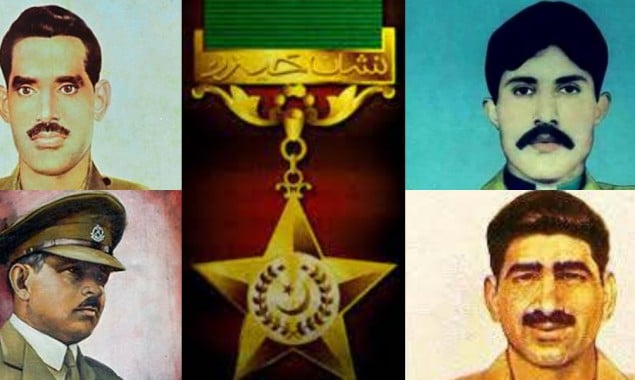
There is a land of martyrs which is called PakistanFlag of Pakistan. They Gave Their today So That we can have a better tomorrow. Our Pride Our Heroes Our Protectors. The nation is celebrating Defence Day with great zeal and fervor. On account of this day, let’s recall the sacrifices of Nishan e Haider holders who showed utmost gallantry on the face of war.
Major Tufail Mohammad (SHAHEED)
The brave Major was martyred on August 7, 1958, in Lakhimpur. He belonged to the 16th Punjab Regiment, Pakistan Rifles. In 1958, Pakistan and India were at daggers drawn at each other over the conflict of East Pakistan. Major Tufail’s Company encompassed the Indian post, which was illegally established inside Pakistan’s territory. He bravely attacked the post and got immensely hurt in the skirmish. His injuries did not stop him and fought without a weapon. In a hand to hand combat, Major Tufail succeeded in defeating Indians and killed 3 of their soldiers and made the others prisoner of war. Sadly, the brave major espoused martyrdom due to severe injuries and received Nishan-e-Haider.
Major Muhammad Akram
Major Muhammad Akram belonged to 4 Frontier Force Regiment and got martyred on December 5, 1971. The intrepid major was the commanding officer of his company in the 1971 Indo-Pak war. His company was obstructing the route of the enemy; hence, the company was under immense fire from the opponent. However, the major successfully obstruct the opposition for two weeks and finally embraced Shahadat in close combat with the enemy.
Muhammad Mahfuz
Naik Muhammad Mahfuz (born 25 October 1944) was a Pakistani soldier, who was awarded the Nishan-i-Haider, the highest military award of Pakistan. He died during the Indo-Pakistani War of 1971. On 17 December 1971, his company was pinned down by the enemy fire and his machine-gun was destroyed by an Indian shell. Even though he was wounded in his legs by shrapnel, he moved towards an enemy bunker from which fire had caused many Pakistani deaths. There he was strangled with one of the enemy soldiers when he killed by another with a bayonet.
Major Raja Aziz Bhatti
The brave major was martyred on September 10, 1965, and hailed from 17 Punjab Regiment. In the 1965 conflict between Indian and Pakistan, he was the commanding officer in an area called Burki at the Lahore sector. His company was facing heavy artillery fires for continuous five days, but he never backed down. However, on September 10 while directing and artillery attack he got hit by a tank shell and espoused Shahadat.
Muhammad Hussain Janjua
Hussain Janjua belonged to 20 Lancers Regiment and got martyred on December 10, 1971. Although he was a driver, he was always avid in doing extraordinary jobs. During the conflict, he saw that the enemy was digging in the Harar Khurd village, he directed the army and the army destroyed sixteen Indian tanks. While directing he was shot by a machine gun; thus, embraced Shahadat and got Nishan-e-Haider.
Havaldar Lalak Jan
Havaldar Lalak Jan embraced Shahadat on 7 July 1999 and hailed from Northern Light Infantry Regiment. The chivalrous soldier offered himself and volunteered on being deployed at top front positions. The brave Havaldar wreaked havoc on the enemy with some of the major losses. On the day of his martyrdom, the brave soldier got seriously injured due to heavy attacks of the enemy but still defended the land, he was situated on. Later on, succumbed to his wounds and got Nishan-e-Haider.
Rashid Minhas
Pilot Rashid Minhas, was inducted in the regiment number 2, Fighter Conversion Unit (FCU) and was martyred on August 20, 1971. On the day of his martyrdom, a Bengali Pilot deliberately forced into his cockpit while he was taking his aircraft in the direction of the runway. The Instructor Pilot(IP) gained control of the craft and went towards India. After getting consciousness, the brave Rashid Minhas realized the situation and being unable to fight the Bengali owing to injuries he pushed the plane and crashed it. He successfully crashed the aircraft inside Pakistan’s Territory. He sacrificed his life for the dignity of the nation and was awarded Nishan-e-Haider.
Captain Raja Muhammad Sarwar
Captain Raja espoused Shahadat on July 27, i948, and belonged to Punjab Regiment. In 1948, in a war over Kashmir with India Captain Sarwar initiated an attack in the Uri Sector and greatly damaged the enemy. He volunteered to destroy the enemy’s spiked wires in order to advance his forces into the rival’s sector. However, in doing that he got martyred and was awarded Nishan-e-Haider.
Major Shabbir Sharif
In the Indo-Pakistani War of 1971, the Pakistan Army launched an offensive on the Western front against the enemy. Sharif, as commander of a company of 6 Frontier Force Regiment, was ordered to capture high ground overlooking Grumukhi Khera and Beri, a village in the Sulemanki Sector.
On 3 December 1971, in a well-organized action, he fought alongside his men and held Indian attacks at bay. He cleared the Jhangar post by passing through the minefield laid by the enemy and swimming across a water obstacle, the ‘Sabuna distributary’, whilst under intense enemy fire and led his company to capture the objective.
On the afternoon of 6 December, the enemy launched an offensive preceded by airstrikes and heavy artillery shelling. After casualties amongst the crew, he took over as a gunner on an anti-tank gun and started firing on the enemy tanks. While this fight was on, one of the enemy tanks fired at him thus killing him. His last words were quoted as: “Don’t lose the bridge.” It was the same bridge he died defending from the Indian Army’s attack.
Captain Karnal Sher Khan
During the Kargil War, he was deployed at the Gultari region. He along with his fellow soldiers established five strategic posts at a height of 17,000 feet at Gultari. Indian Army launched eight attacks on their position to capture the strategic posts. However, Khan and his men were able to defend those strategic posts. On 5 July 1999, the Indian army launched another attack and surrounded his posts with two battalions. With heavy mortar fire, the Indian Army captured one of his posts. Khan personally led a successful counter-attack and was able to re-capture the lost post. Despite the shortage of ammunition and men, Khan was successful in forcing the enemy to retreat. However, during the battle, he was hit by machine-gun fire and was killed.
Read More News On
Catch all the Pakistan News, Breaking News Event and Latest News Updates on The BOL News
Download The BOL News App to get the Daily News Update & Follow us on Google News.




